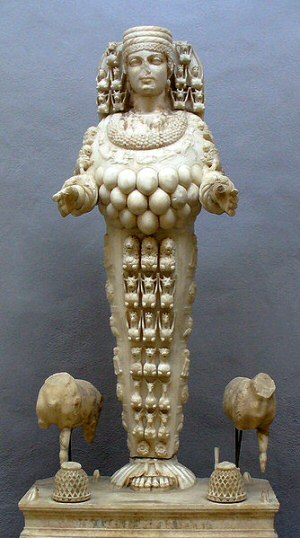Ancient Greek Religion
The Temple of Artemis at Ephesus
pre-Classical Greece—3rd century AD, Selçuk, Turkey.
The mass of protuberances on the chest of Artemis have been variously interpreted as eggs or breasts, but perhaps the temple was so high because the goddess inside it was depicted as a great fruit tree.

'The Temple of the goddess Artemis at Ephesus, on the eastern coast of the Aegean sea in what is now Turkey, was regarded as one of the seven wonders of the ancient world. Constructed in the six century BC as a replacement for older temples, the building was so spectacular that one ancient writer, who claims to have seen all the seven wonders at first hand, was more impressed with it even than he was of the pyramids of Egypt! It reached, he said, into the clouds,' said Miranda.
'When the Greeks colonised the eastern Aegean, long before the building of this famous Temple, there was a temple already on the site at Ephesus; there had been since the Bronze Age. The goddess worshipped there was almost certainly a form of Cybele, and when the Greeks arrived she was incorporated into the Greek pantheon as Artemis, goddess of the woodland and of the moon, and sister to Apollo, the sun.
'From an engraving of a Greek replica of the famous image of Artemis at the Temple at Ephesus, and a surviving statue of Artemis of the 1st century AD, it is clear that she had a large number of decorative features that have been variously interpreted as breasts or eggs, hanging about her chest...'
'Could have been fruit,' interrupted Quintin. 'Her legs are bound together to make them look like a tree trunk. Maybe that was why the temple was so high; the goddess inside it was depicted as a great fruit tree. And a votive inscription of the 3rd century BC once described her as the Cretan Artemis at Ephesus.'
'Well, eggs or breasts or fruit, she was certainly a fertility goddess,' said Miranda, 'But we will never know for sure what her statue looked like, because by the end of the fourth century the local Christians were using what remained of the temple as a stone quarry.'